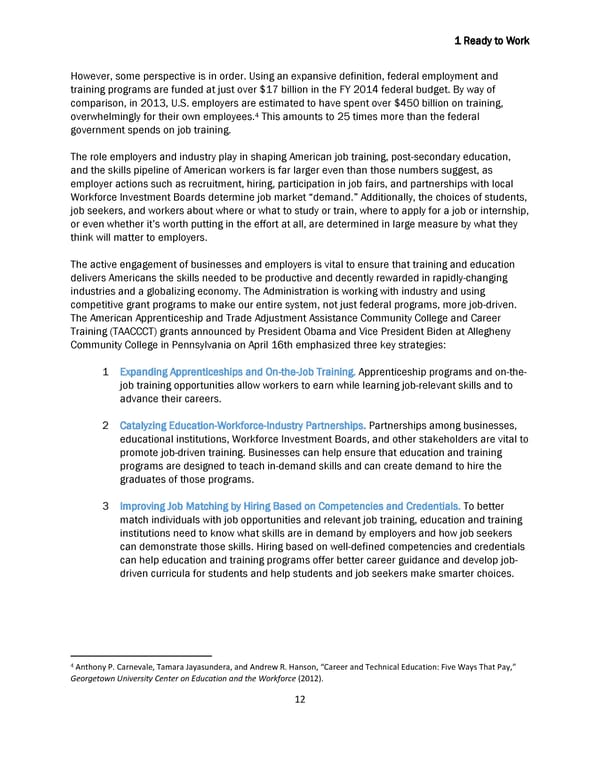1 Ready to Work However, some perspective is in order. Using an expansive definition, federal employment and training programs are funded at just over $17 billion in the FY 2014 federal budget. By way of comparison, in 2013, U.S. employers are estimated to have spent over $450 billion on training, 4 overwhelmingly for their own employees. This amounts to 25 times more than the federal government spends on job training. The role employers and industry play in shaping American job training, post-secondary education, and the skills pipeline of American workers is far larger even than those numbers suggest, as employer actions such as recruitment, hiring, participation in job fairs, and partnerships with local Workforce Investment Boards determine job market “demand.” Additionally, the choices of students, job seekers, and workers about where or what to study or train, where to apply for a job or internship, or even whether it’s worth putting in the effort at all, are determined in large measure by what they think will matter to employers. The active engagement of businesses and employers is vital to ensure that training and education delivers Americans the skills needed to be productive and decently rewarded in rapidly-changing industries and a globalizing economy. The Administration is working with industry and using competitive grant programs to make our entire system, not just federal programs, more job-driven. The American Apprenticeship and Trade Adjustment Assistance Community College and Career Training (TAACCCT) grants announced by President Obama and Vice President Biden at Allegheny Community College in Pennsylvania on April 16th emphasized three key strategies: 1 Expanding Apprenticeships and On-the-Job Training. Apprenticeship programs and on-the- job training opportunities allow workers to earn while learning job-relevant skills and to advance their careers. 2 Catalyzing Education-Workforce-Industry Partnerships. Partnerships among businesses, educational institutions, Workforce Investment Boards, and other stakeholders are vital to promote job-driven training. Businesses can help ensure that education and training programs are designed to teach in-demand skills and can create demand to hire the graduates of those programs. 3 Improving Job Matching by Hiring Based on Competencies and Credentials. To better match individuals with job opportunities and relevant job training, education and training institutions need to know what skills are in demand by employers and how job seekers can demonstrate those skills. Hiring based on well-defined competencies and credentials can help education and training programs offer better career guidance and develop job- driven curricula for students and help students and job seekers make smarter choices. 4 Anthony P. Carnevale, Tamara Jayasundera, and Andrew R. Hanson, “Career and Technical Education: Five Ways That Pay,” Georgetown University Center on Education and the Workforce (2012). 12
 Biden Ready to Work White Paper 7/22/14 Page 11 Page 13
Biden Ready to Work White Paper 7/22/14 Page 11 Page 13